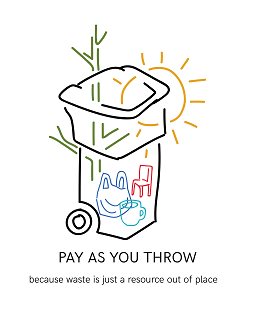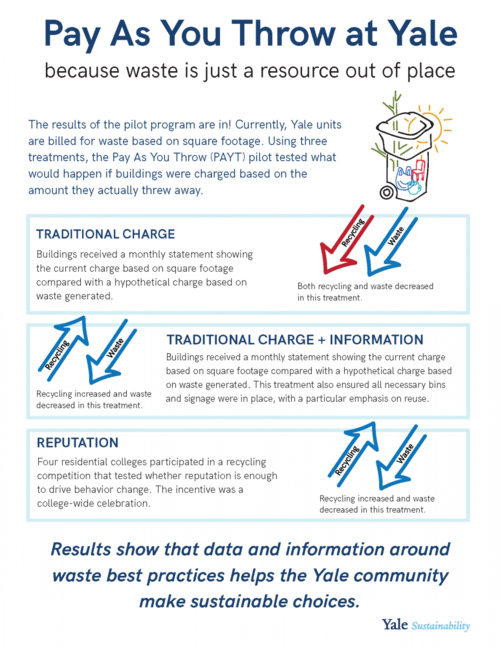Because waste is just a resource out of place
Pay As You Throw (PAYT) is a materials management model where entities (typically homeowners) are charged for the amount of trash that they throw away, much like they are charged for the use of other utilities such as electricity. Charging more for garbage than recycling or composting, PAYT works to encourage more environmentally-sustainable waste habits.
FAQ
What is Pay As You Throw (PAYT)?
Why did Yale pursue a PAYT pilot?

Yale’s PAYT pilot aimed to reduce waste on campus and inspire lasting behavioral change. One of the goals in the Yale Sustainability Plan 2025 is to create, pilot, and assess a “pay as you throw” (PAYT) system at Yale by January 2022. A task force of Yale faculty, administrators, and students developed a strategy to implement and assess a PAYT pilot to study how this approach might work within the university context.
What did we hope to accomplish with the pilot?
We hoped that a PAYT program at Yale would reduce waste and increase reuse and recycling by incentivizing participants to generate less trash. It should:
- Make our community more conscious of their decisions as consumers
- Decrease campus use of natural resources, greenhouse gas emissions, and other air pollutants
- Create opportunities for academic research and collaboration between faculty, students, and operational staff
What did the pilot involve?

How long did the pilot run?
The pilot took place from January–April 2019.
How much were buildings charged?
No buildings received any additional charges. Buildings in the traditional charge group and traditional charge plus information group received test bills only. The test bills reflected what would be charged based on amount of waste generated, rather than on square footage. Residential colleges in the reputation group received monthly data updates showing how they compared to other buildings in the group.
What were the results of the pilot?
The pilot showed that receipt of data and information is valued by the Yale community and can lead to both a decrease in waste and an increase in recycling. Qualitatively, it showed that a university-wide traditional PAYT scheme would require significant changes to the infrastructure of Yale’s waste system: because a PAYT model seeks to charge buildings based on the amount of waste they produce, better ways of differentiating waste production would be needed. Read the Pay as You Throw Final Report.
Help! None of these questions answer what I am looking for.
Please reach out to sustainability@yale.edu.